Abstract
OBJECTIVES:
To determine awareness about hepatitis C among 4th -year medical students at Dammam University, on hepatitis C and possible associated factors.
MATERIALS AND METHODS:
A cross-sectional study was conducted using a self-administered questionnaire comprising questions on awareness of hepatitis C virus (HCV) transmission, screening of the population, symptoms, complications, prevention, and treatment.
RESULTS:
A total of 201 students participated, with a response rate of 79.8%. About 75% of students had a poor grasp of HCV transmission while the awareness of <25% of students was fair. More than half of students had fair knowledge about screening, prevention, and treatment of HCV. The majority of students were familiar with the clinical presentation and complications of HCV. The overall awareness of the 4th -year medical students on HCV infection was fair, with no significant difference between males and females.
CONCLUSIONS:
Overall grasp of hepatitis C by the studied group was fair. However, there were serious gaps in their knowledge, which need to be filled or modified, especially knowledge about transmission which was poor.
Key words: Awareness, clinical training, hepatitis C, students
Introduction
Hepatitis C virus (HCV) is considered a worldwide health problem, which can cause both acute and chronic hepatitis infection. The infection of most acutely infected people eventually becomes chronic.[1] Cirrhosis, portal hypertension, hepatic decompensation, and hepatocellular carcinoma are examples of the complications of severe hepatitis C,[1] which result in around 500,000 deaths per year.[2]
Generally, HCV is a blood-borne infection which can be transmitted through the receipt of donated blood or organs, intravenous drug use, sharing of drug paraphernalia, and reuse of injection needles. About 2–8% of HCV-infected mothers infect their children during pregnancy. Sexually transmitted infection has been disputed.[1] There is no available vaccine for hepatitis C till now, but research for this is in progress.[3]
Worldwide, more than 170 million people have been infected with HCV. This includes around 23 million persons in the Middle East region, which represents 1–2% of overall prevalence. Egypt is said to have the highest prevalence internationally with an estimated 14.7% of the total population being seropositive for HCV.[4]
The number of studies on HCV in Saudi Arabia is limited. However, the average prevalence of 124 infected persons per 100,000 population by region is demonstrated in the study done by Madani between January 1995 and December 2005.[5] Of the 74,662 individuals tested in a premarital screening program in 2008,[6] the average prevalence was 0.33%. The prevalence in Saudi hemodialysis patients is higher, ranging from 15% to 95% by region,[7] than in the general population. A study by Alzahrani et al. showed that 38% of 344 Saudi drug users' blood contained detectable HCV RNA.[8]
In the study conducted by Al-Ajlan, the prevalence of hepatitis C marker among the students admitted in the health colleges and institutes in Saudi Arabia was lower than in the general population.[9]
Alqahtani et al. in their study conducted in Najran region of Southwestern Saudi Arabia, reported that knowledge of blood-borne diseases transmitted occupationally and the level of compliance with standard isolation precautions was poor among medical students and mediocre among health-care workers.[10]
The study from Guilan University in Iran reported that knowledge of HCV among medical students globally is relatively low.[11] However, the studies from medical colleges of Karachi[12] and Bitola in Macedonia[13] showed medical students' knowledge of HCV as satisfactory.
Good knowledge and proper attitude of medical students toward HCV infection are very important in preventing the spread of the disease among them and the patients because of their close contact with hepatitis C patients in the course of their study, and as future health care workers.[11]
In Saudi medical colleges, 4th -year medical students are the most junior members of the medical team. They are the first to encounter patients in real clinical practice. They may be involved in certain procedures, which, without any clinical experience and skills, would expose them to many infectious diseases including hepatitis C infection.
This study was designed to determine the awareness about hepatitis C infection among fourth year medical students of the College of Medicine in Dammam University, Saudi Arabia.
Materials and Methods
This cross-sectional study was conducted to assess awareness of hepatitis C infection. The study population included all male and female 4th -year medical students at the College of Medicine, University of Dammam, Eastern Saudi Arabia. A total of 253 (males and females) were approached. Two hundred and one medical students completed the questionnaire giving a response rate of 79.8%. The data were collected by means of a structured, self-administered questionnaire, the design of which was based on the objectives of the study by the researchers after a review of recent literature and similar questionnaires. The questionnaire comprised two main parts with questions on (1) sociodemographic data as age, gender, and marital status and other information related to hepatitis C such as history of HCV screening, needle stick injury, and family history of hepatitis C infection; (2) awareness of the students on modes of HCV transmission, screening groups for hepatitis C, symptoms and complications of hepatitis C, and prevention and treatment of hepatitis C. The participants were requested to respond to questions according to their own awareness of the subject. The scoring system was based on giving a value of one for each correct item and a value of zero for the wrong item. The awareness score of ≤50% was considered to represent poor awareness ; 50%-75% was considered as fair awareness ; and >75% was considered as represent good awareness about hepatitis C.
A pilot study was conducted on ten students – different from the target group – to check understanding and applicability of the questionnaire. The questionnaire was reviewed by researchers before and after pilot study. Based on the results, some linguistic and technical modifications were made to remove any ambiguity from the questions and make them easier to understand and interpret. The questionnaire was validated after modification and reviewed by two faculty members separately. The revised questionnaires were compared and the necessary modifications made before final approval was given by the reviewers. The study was approved by the Ethical Committee of Postgraduate Saudi Board Program, Eastern Province, and any other necessary authorization was obtained to conduct the study. The participants were approached in their lecture halls and invited to participate. A meeting was held with them and the purpose of the study explained. They were reassured that the responses to the questionnaires would be anonymous and that the collected data will be kept confidential and used only for research. As part of the introduction to the survey, the questionnaire was explained and all issues raised were answered before obtaining their informed consent. The filled questionnaires were reviewed for completeness and invalid questionnaires were excluded, yielding a final sample size of 201. The data were coded, entered, and analyzed in a personal computer using Statistical Package for Social Sciences software version 20. Data were presented using descriptive statistics in the form of frequencies and percentages for qualitative variables and mean and standard deviation (SD) for quantitative variables. Chi-square test and/or logistic regression analysis were used as appropriate to determine the association.
Results
Two hundred and one students participated in this study. The mean age ± SD was 21.27 ± 0.78 years and more than half of participants (59.2%) were females. The majority were single (83.1%).
Table 1 shows hepatitis C-related characteristics of 4th -year medical students participating in this study. Approximately two-thirds (61.2%) of students were not screened for hepatitis C and a quarter of them did not know if they were screened. Needle stick injury was positive in 8.5% students and 3.5% of them had a family history of hepatitis C.
Table 1.
Hepatitis C related characteristics of study participants (n=201)
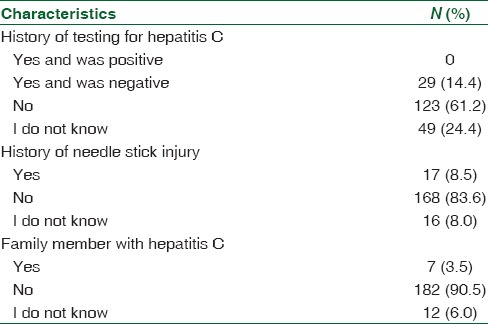
The responses of students regarding the efficiency of HCV transmission is shown in Table 2. Generally, knowledge of most of the questions on transmission was poor (18 out of 24 questions) apart from awareness of efficient transmission through injection by drug users, through blood transfusion, and organ donation. Correct answers were 87.8%, 85.4%, 70.7%, respectively, in males and 84.9%, 93.3%, 83.2% respectively, in females. In addition, awareness of inefficient transmission by the fecal-oral route, handshake, and toilet seats was as follows: Correct answers were 73.2%, 84.1%, 51.2%, respectively, for male students and the correct answers were 68.1%, 81.5%, 48.7%, respectively, for females. There were significant differences regarding answers to questions on transmission through hemodialysis, transplant from an infected donor, and unsafe injection practice, the results being better in females than males. There was a significant difference on awareness of transmission through the sharing of contaminated toothbrushes, male being better in this area.
Table 2.
Response of 4th-year medical students to questions regarding the efficiency of transmission of hepatitis C virus

Table 3 illustrates 4th -year medical students' awareness about screening groups for hepatitis C. Generally, most of the responses showed that awareness of screening for hepatitis C was fair to good (nine out of 12 questions). However, awareness of screening pregnant women for hepatitis C and before major surgeries was poor (6.1%, 22.0%, respectively, in males and 8.4%, 16.8%, respectively, in females).
Table 3.
Awareness of 4th-year medical students about target groups for hepatitis C screening
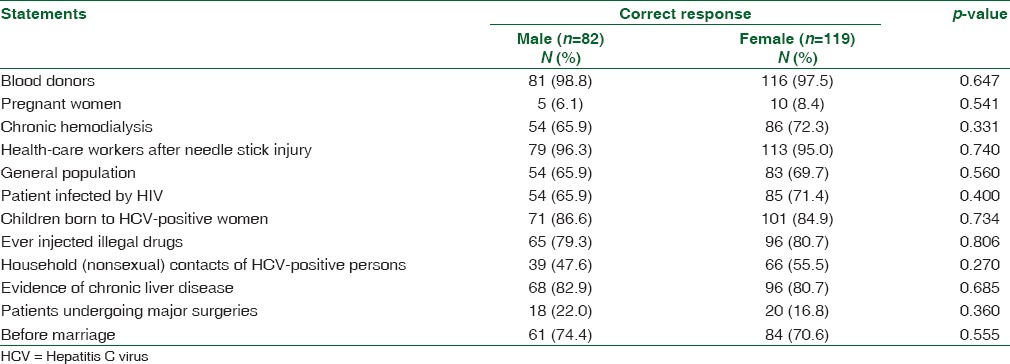
All students' responses to clinical presentation and complications of hepatitis C infection were correct with more than half of students getting a high grade to questions asking if hepatitis C can lead to liver cirrhosis [Table 4]. Awareness of prevention and treatment of hepatitis C is presented in Table 5. In general, the percentage of students' correct answers was fair on whether hepatitis C patients can be treated with antibiotics and if it can be prevented by avoiding contaminated water. Awareness of the use of immunoglobulin as prophylaxis for needle stick injury in hepatitis C was poor.
Table 4.
Awareness of 4th-year medical students about clinical presentation and complications of hepatitis C infection

Table 5.
Awareness of 4th-year medical students about prevention and treatment of hepatitis C

The majority of students had poor awareness of the modes of HCV transmission (approximately 77.1%). More than half of students had fair knowledge of screening for HCV (56.2%) and prevention and treatment of HCV (58.7%). On the other hand, approximately 73% of males and 71% of females knew the clinical presentation and complications of HCV. The overall awareness of 4th -year medical students of HCV infection was fair (69.7%). There were no statistical differences between males and females on the awareness subscores or the general awareness score [Tables 6 and 7].
Table 6.
Awareness score of about hepatitis C among 4th-year medical students (both males and females)
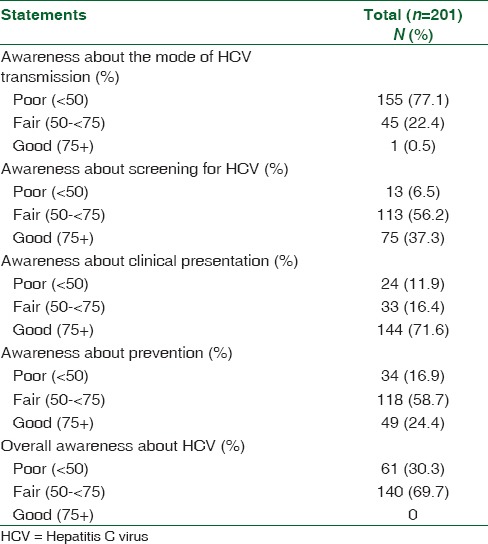
Table 7.
The awareness score of about hepatitis C among 4th-year medical students (males versus females)
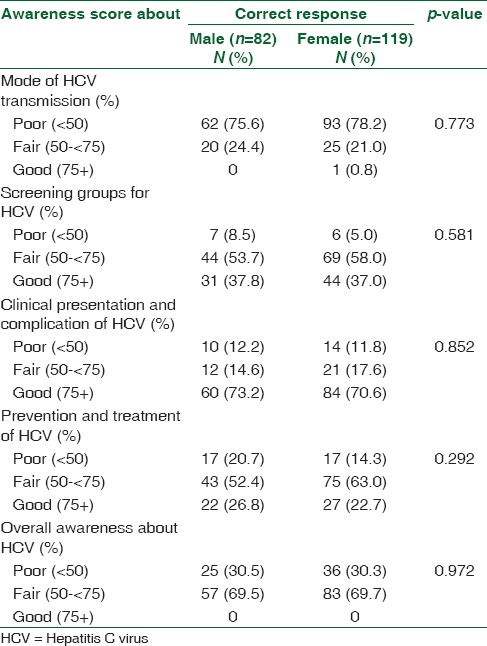
Regarding marital status, it was noted that a significantly higher percentage of the single students (72.5%) compared to married students (57.6%) had fair overall knowledge of HCV (P = 0.045). There was no significant correlation between the overall awareness score and the history of needle stick injury, previous testing for hepatitis C, and family history of hepatitis C [Table 8].
Table 8.
Correlation with overall awareness score about hepatitis C virus with hepatitis C-related characteristics of the study population
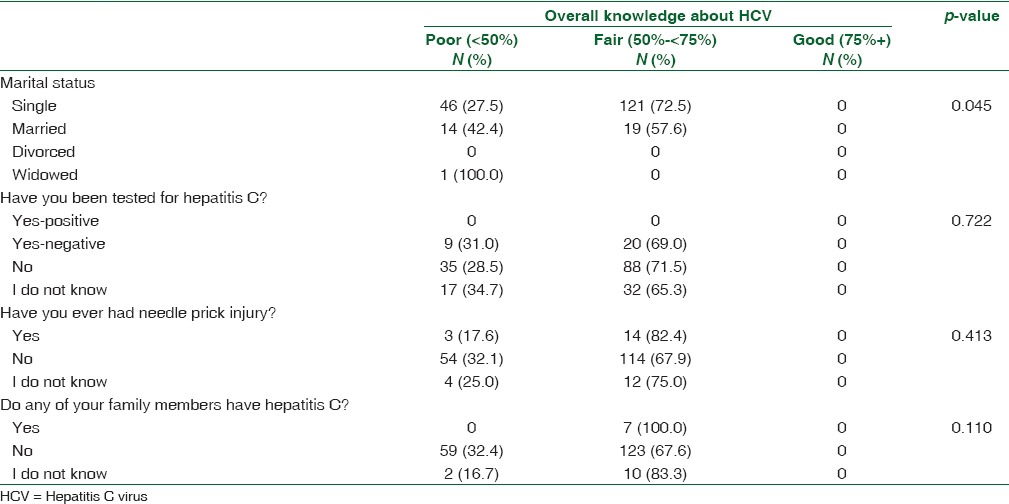
Discussion
The current study was conducted among 4th -year medical students who are expected to have adequate background knowledge and a cautious attitude toward such contagious diseases as hepatitis C.
Regarding the mode of HCV transmission, our study has shown that the level of awareness of both males and females was poor. However, the scores to some questions were good such as those on injections of drug users, infection through blood transfusion, and organ donation. These results were similar to findings reported by the study in University of Lome students.[14] In the Medical College of Bitola, students showed a high-level of awareness of HCV transmission,[13] and more than half of the medical students in medical colleges of Karachi, Pakistan, revealed excellent knowledge of HBV and HCV transmission.[12]
The students in this study showed good knowledge of the clinical presentation of hepatitis C. Similar results on the diagnosis of hepatitis B and C were reported of Karachi medical students,[12] but our results were better than those of the medical students in Guilan University, Iran, which were poor.[11]
Persons with HCV infection are often asymptomatic and may not even be aware that they are infected though they are capable of infecting others.[1,2] Most of the medical students as in the Mansour-Ghanaei's study were unaware of the asymptomatic nature of HCV infection.[11] In the present study, most of the medical students knew that persons infected with hepatitis C can be asymptomatic. This was consistent with the responses reported in the study by Khan et al.[12]
The present study reported that more than half of medical students had fair knowledge of the treatment of Hepatitis C, which was better than the results of Karachi[12] and Guilan University medical students.[11]
This study revealed that only 12.2% of males and 9.2% of females were aware that immunoglobulin is not used for postexposure of hepatitis C. In a study conducted in Western Saudi Arabia by Al-Zahrani et al., 52.3% of physicians knew that there was no specific prophylaxis after exposure to HCV.[15]
In 69.6% of the studied group, the overall level of awareness of hepatitis C was fair. These results were better than a study among Najran medical students which found poor or inadequate knowledge of blood-borne infections.[10] The mean knowledge levels of medical students of Guilan University of hepatitis C were relatively low.[11] In study by Hu et al. Taiwanese dental students were uncertain of HCV infection, and their knowledge level was significantly lower on HCV than HBV and HIV.[16] However, present study was comparable to the result of a study conducted in medical colleges in Karachi by Khan et al., which showed the overall knowledge of students about hepatitis B and C between 50% and 70%.[12]
In their study of medical students in Guilan University, Mansour-Ghanaei found that the level of HCV awareness and knowledge were high among married participants.[11] However, in this study, there was significant correlation between marital status and knowledge of hepatitis C in favor of unmarried students. This could be explained by the presence of a large proportion of unmarried to married students in our study group. Gender, family history of hepatitis C, and history of needle stick injury were not associated with any significant difference in awareness level. This is in agreement with the result of a survey conducted among the students of Guilan University.[11]
Conclusions
Although the study group's overall level of knowledge of hepatitis C was fair, there were serious gaps which need to be filled or modified. Unfortunately, there was poor knowledge among both males and females with regard to transmission. Since various aspects of hepatitis C infection had been covered in the preclinical subjects like, pathology, virology, and public health, the knowledge in our study population (4th -year medical students) was expected to be better.
The 4th year is the 1st clinical year of clinical exposure to patients, which means these students ought to be particularly mindful of protecting themselves and others. In addition, since hepatitis C infection in particular has no postexposure prophylaxis, prevention of infection is the only option and is of paramount importance.
Recommendation
Revise the undergraduate curricula to ensure knowledge about blood-borne infections in general and hepatitis C in particular
There should be preclinical practical courses to raise awareness and improve the attitude of 4th -year medical students to blood-borne infections in general and hepatitis C in particular before there is any clinical exposure.
Financial support and sponsorship
Nil.
Conflicts of interest
There are no conflicts of interest.
References
- 1.Webster DP, Klenerman P, Dusheiko GM. Hepatitis C. Lancet. 2015;385:1124–35. doi: 10.1016/S0140-6736(14)62401-6. [DOI] [PMC free article] [PubMed] [Google Scholar]
- 2.World Health Organization. Hepatitis C. 2015. Jul, [Last accessed on 2016 Apr 13]. Available from: http://www.who.int/mediacentre/factsheets/fs164/en/
- 3.Centers for Disease Control and Prevention. Hepatitis C FAQs for Health Professionals. 2016. Mar 11, [Last accessed on 2016 Apr 13]. Available from: http://www.cdc.gov/hepatitis/hcv/hcvfaq.htm .
- 4.Esmat G. Hepatitis C in the eastern Mediterranean region. East Mediterr Health J. 2013;19:587–8. [PubMed] [Google Scholar]
- 5.Madani TA. Hepatitis C virus infections reported over 11 years of surveillance in Saudi Arabia. Trans R Soc Trop Med Hyg. 2009;103:132–6. doi: 10.1016/j.trstmh.2008.08.001. [DOI] [PubMed] [Google Scholar]
- 6.Alswaidi FM, O'Brien SJ. Is there a need to include HIV, HBV and HCV viruses in the Saudi premarital screening program on the basis of their prevalence and transmission risk factors? J Epidemiol Community Health. 2010;64:989–97. doi: 10.1136/jech.2009.093302. [DOI] [PubMed] [Google Scholar]
- 7.Al Balwi MA. Prevalence of mixed hepatitis C virus (HCV) genotypes among recently diagnosed dialysis patients with HCV infection. Saudi J Kidney Dis Transpl. 2011;22:712–6. [PubMed] [Google Scholar]
- 8.Alzahrani AJ, Dela Cruz DM, Obeid OE, Bukhari HA, Al-Qahtani AA, Al-Ahdal MN. Molecular detection of hepatitis B, hepatitis C, and torque teno viruses in drug users in Saudi Arabia. J Med Virol. 2009;81:1343–7. doi: 10.1002/jmv.21487. [DOI] [PubMed] [Google Scholar]
- 9.Al-Ajlan A. Prevalence of hepatitis B and C among students of health colleges in Saudi Arabia. East Mediterr Health J. 2011;17:759–62. doi: 10.26719/2011.17.10.759. [DOI] [PubMed] [Google Scholar]
- 10.Alqahtani JM, Abu-Eshy SA, Mahfouz AA, El-Mekki AA, Asaad AM. Seroprevalence of hepatitis B and C virus infections among health students and health care workers in the Najran region, Southwestern Saudi Arabia: The need for national guidelines for health students. BMC Public Health. 2014;14:577. doi: 10.1186/1471-2458-14-577. [DOI] [PMC free article] [PubMed] [Google Scholar]
- 11.Mansour-Ghanaei R, Joukar F, Souti F, Atrkar-Roushan Z. Knowledge and attitude of medical science students toward hepatitis B and C infections. Int J Clin Exp Med. 2013;6:197–205. [PMC free article] [PubMed] [Google Scholar]
- 12.Khan N, Ahmed SM, Khalid MM, Siddiqui SH, Merchant AA. Effect of gender and age on the knowledge, attitude and practice regarding hepatitis B and C and vaccination status of hepatitis B among medical students of Karachi, Pakistan. J Pak Med Assoc. 2010;60:450–5. [PubMed] [Google Scholar]
- 13.Prodanovska-Stojcevska V, Isjanovska R, Popova-Ramova E. Knowledge of HCV infection among nursing students of the Medical College of Bitola. Arh Hig Rada Toksikol. 2010;61:197–201. doi: 10.2478/10004-1254-61-2010-1990. [DOI] [PubMed] [Google Scholar]
- 14.Bagny A, Bouglouga O, Djibril MA, Kaaga YL, Dusabe A, Lawson AL, et al. Knowledge and attitudes of students towards viral hepatitis B and C at the University of Lome. Indian J Gastroenterol. 2015;34:78–9. doi: 10.1007/s12664-014-0479-6. [DOI] [PubMed] [Google Scholar]
- 15.Al-Zahrani AO, Farahat F, Zolaly EN. Knowledge and practices of healthcare workers in relation to bloodborne pathogens in a tertiary care hospital, Western Saudi Arabia. J Community Health. 2014;39:959–64. doi: 10.1007/s10900-014-9837-7. [DOI] [PubMed] [Google Scholar]
- 16.Hu SW, Lai HR, Liao PH. Comparing dental students' knowledge of and attitudes toward hepatitis B virus-, hepatitis C virus-, and HIV-infected patients in Taiwan. AIDS Patient Care STDS. 2004;18:587–93. doi: 10.1089/apc.2004.18.587. [DOI] [PubMed] [Google Scholar]


